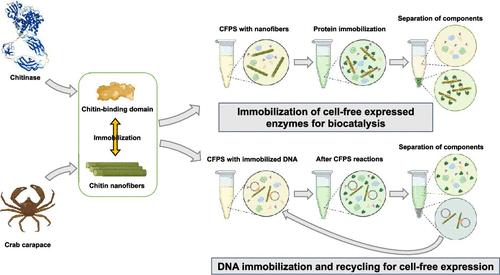几丁质功能化的无细胞系统实现可持续的生物催化和基因表达
IF 7.3
1区 化学
Q1 CHEMISTRY, MULTIDISCIPLINARY
引用次数: 0
摘要
无细胞蛋白合成(Cell-free protein synthesis, CFPS)已被证明是表达多种蛋白质和酶的宝贵技术,具有操作简便、传质迅速和生产率高等显著优势。然而,传统的无细胞表达系统通常以批处理形式反应,这给生物催化中的酶再利用带来了挑战,并且使补充的基因模板不可回收。为了克服这一限制,我们引入了一种几丁质功能化的CFPS系统,旨在固定化体外表达的酶和基因模板,用于可持续的生物催化和蛋白质合成。该系统的核心是利用几丁质结合域(ChBD)和结晶几丁质纳米纤维(ChNFs)之间的强结合亲和力。具体来说,我们设计了ChBD与靶蛋白和酶的融合,允许它们在chnf上无细胞表达和原位固定。这有利于多种生物催化反应中酶的轻松回收,而chfs固定化酶也可以部署在连续流生物催化装置中。利用ChBD-ChNF配对,基因模板同样可以固定和循环用于持续的基因表达。我们的研究结果表明,甲壳素功能化的无细胞体系通过ChNF材料的固定可以显著提高CFPS的性能。这项工作强调了无细胞系统的灵活性和稳健性,它可以与化学和材料科学等领域的先进技术无缝集成,以实现有影响力的应用。本文章由计算机程序翻译,如有差异,请以英文原文为准。

Chitin-Functionalized Cell-Free System Enables Sustainable Biocatalysis and Gene Expression
Cell-free protein synthesis (CFPS) has proven invaluable for expressing a wide array of proteins and enzymes, boasting significant advantages, such as facile manipulation, rapid mass transfer, and high productivity. However, traditional cell-free expression systems typically operate in batch format reactions, posing challenges for enzyme reuse in biocatalysis and rendering supplemented gene templates nonrecyclable. To overcome this limitation, we introduce a chitin-functionalized CFPS system designed to immobilize in vitro-expressed enzymes and gene templates for sustainable biocatalysis and protein synthesis. At its core, this system capitalizes on the strong binding affinity between a chitin-binding domain (ChBD) and crystalline chitin nanofibers (ChNFs). Specifically, we engineer ChBD fusion with target proteins and enzymes, allowing for their cell-free expression and in situ immobilization on ChNFs. This facilitates the effortless recycling of enzymes for multiple biocatalytic reactions, while ChNFs-immobilized enzymes can also be deployed in continuous flow biocatalysis setups. Leveraging the ChBD-ChNF pairing, gene templates can likewise be immobilized and recycled for sustained gene expression. Our results demonstrate that the chitin-functionalized cell-free system significantly enhances CFPS performance through immobilization with ChNF materials. This work underscores the flexibility and robustness of cell-free systems, which can seamlessly integrate with advanced techniques from fields such as chemistry and materials science for impactful applications.
求助全文
通过发布文献求助,成功后即可免费获取论文全文。
去求助
来源期刊

ACS Sustainable Chemistry & Engineering
CHEMISTRY, MULTIDISCIPLINARY-ENGINEERING, CHEMICAL
CiteScore
13.80
自引率
4.80%
发文量
1470
审稿时长
1.7 months
期刊介绍:
ACS Sustainable Chemistry & Engineering is a prestigious weekly peer-reviewed scientific journal published by the American Chemical Society. Dedicated to advancing the principles of green chemistry and green engineering, it covers a wide array of research topics including green chemistry, green engineering, biomass, alternative energy, and life cycle assessment.
The journal welcomes submissions in various formats, including Letters, Articles, Features, and Perspectives (Reviews), that address the challenges of sustainability in the chemical enterprise and contribute to the advancement of sustainable practices. Join us in shaping the future of sustainable chemistry and engineering.
 求助内容:
求助内容: 应助结果提醒方式:
应助结果提醒方式:


